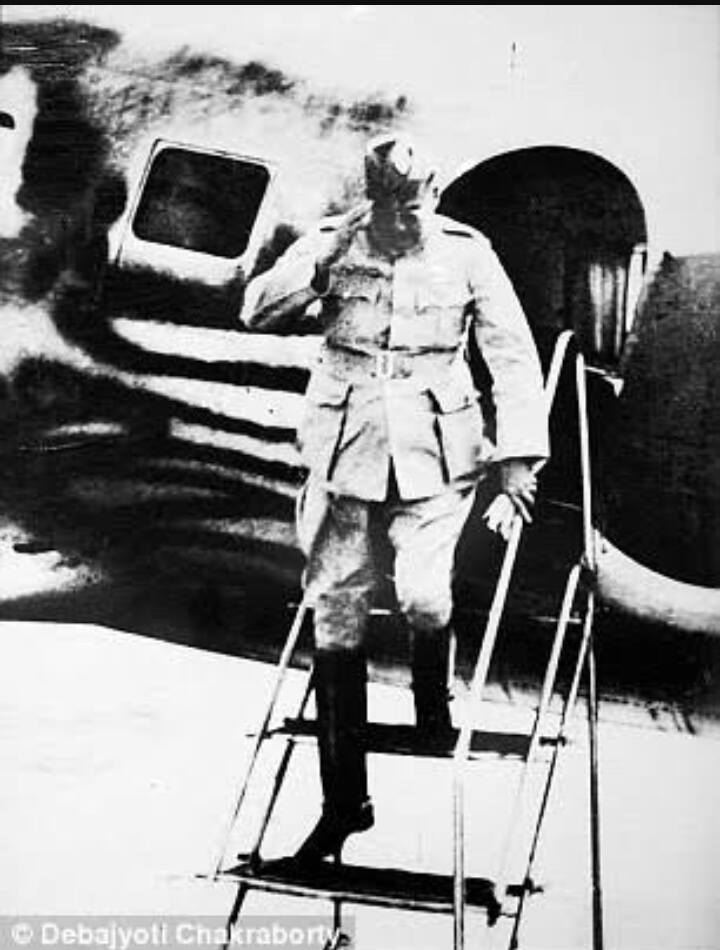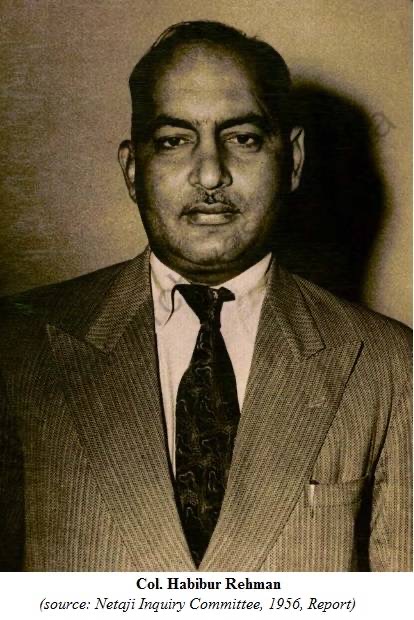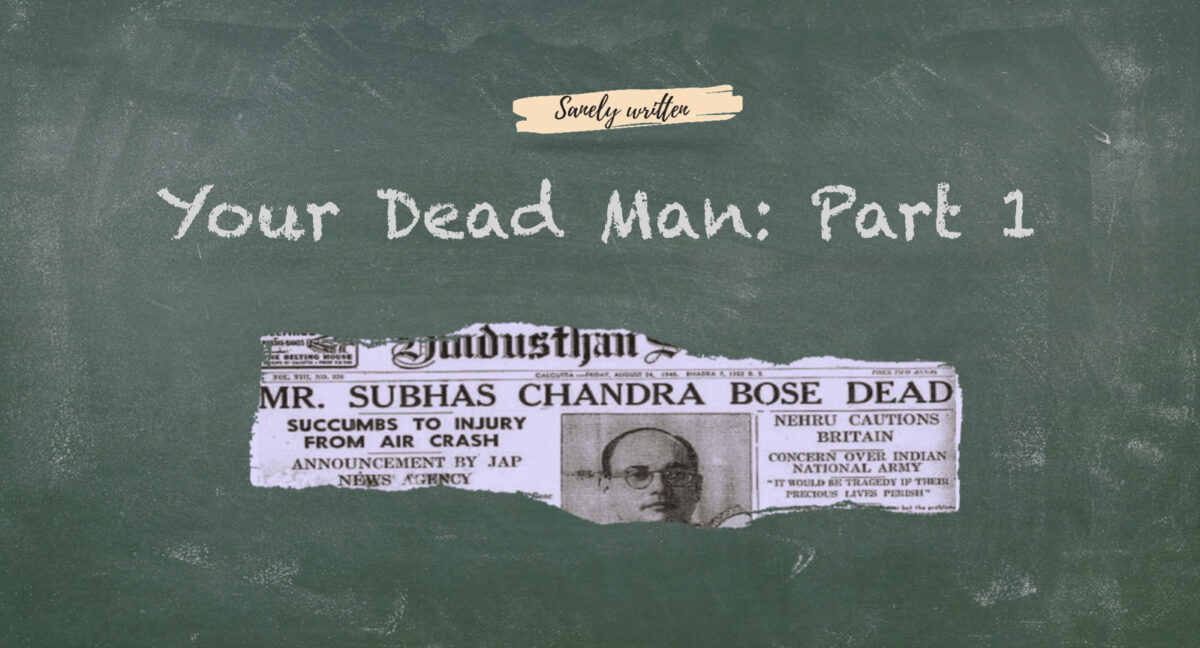“When you go back to the country, tell the people that up to the last I have been fighting for the liberation of my country; they should continue to struggle, and I am sure India will be free before long. Nobody can keep India in bondage now.
These were the words uttered by Dr. Subhash Chandra Bose after he barely crawled out of the plane crash over Taihoku (now Taipei) on 18th August 1945 with severe burns all over his body. These words truly sum up the valour of Netaji and the love he had for his motherland. Unfortunately, these were the last words of the great man as a few hours after this incident he succumbed to his injuries. Or did he?
You must have heard of this story a lot of times, read this in our ever-so-reliable history textbooks, but the reality is nowhere near to what we know. The story of the disappearance of Netaji is a big dark spot in the history of Independent India. Several books have been written on this incident with every author trying to portray their version of the truth. But the reality of what happened with Netaji still hasn’t surfaced. Of all major and minor theories about his supposed death, there are three major theories that “intellectuals” and the Government of India – right from 1947 till date – try and debate. This blog is an attempt to clarify the three major theories, arguments in favour and against them and an attempt from our side for justice to “your dead man”.
Of all the theories floating around, the ones that caught the most attention is the Plane crash over Taiwan on 18th August 1945, his escape to Russia, and the Gumnami Baba story. Let’s dive a little deeper into the first of the three alleged incidents and find out the reality of what actually happened with Netaji.
The Plane crash in 1945:
Before getting into the details of the mystery, let’s get an idea of what were the circumstances that led to the most contested air disaster in Indian history and how Raja Habibur Rahman Khan, a 6-foot sturdy Kashmiri held the key to unlocking the death mystery of Dr. Subhash Chandra Bose.
“The tremendous sacrifices made by the soldiers of the Azad Hind Fauj and the civilian population will not go in vain. …Your efforts should be to see that all we had done in the Far East should be known to our countrymen.” These were the words of Mr. Bose on 14th August 1945 when he called for an urgent meeting in his seashore bungalow after getting the news of the Japanese surrender. Japan was the only benefactor for Bose. A decision was made that the Indian National Army (INA) will surrender as a separate entity and this news is to be conveyed to the Japanese General’s headquarters in Singapore. They had to reassemble the very next day because “the Japanese commander in Singapore could not give an assurance for a separate surrender by Azad Hind Government and Army as he said that he had no such instructions and it would not be practicable for him to get in touch with Tokyo; even wireless communications having been disrupted”. Bose decided that now he himself have to fly to Tokyo in order to finalise the formalities of the surrender.
Bose took off for Bangkok (the then seat of the Provincial Government of Free India or PGFI) on the morning of 16th August 1945 along with S.A. Aiyer, Debnath Das, Colonel Habibur Rahman, Captain Gulzara Singh, Colonel Pritam Singh and Major Abid Hasan. On reaching Bangkok he met with Hachiya Teruo, the minister-designate to the Azad Hind Government, Lt. Gen. Saburo Isoda & Colonel Kagawa of Hikari Kikan, the Japanese military unit liaising with Bose’s government. He was advised to travel to Saigon (now Ho Chi Minh City) and make a contact with Field Marshal Count Terauchi Hisaichi, the commander of the Japanese forces in South East Asia. They offered to accompany him to Saigon as well. So two planes carrying Bose’s men and the Japanese Military personnel took off from Bangkok and landed in Saigon on 17th August 1945. This was the date when the last official Image and video was taken of Dr. Subhash Chandra Bose dressed in his evergreen Khakhi Vardi coming out of a plane.

Reaching Saigon, Bose was informed by Terauchi that he had not received any orders from Tokyo regarding the separate surrender of the INA and it was obvious that Bose himself had to travel to Tokyo and see for the arrangements. Every other member who accompanied Bose on this journey was against the fact of Bose going to Tokyo all by himself. But not all of them could travel with him as there was only one lane available as the allied forces had issued an order to the Japanese government, not to fly any plane without their prior permission. There was only one seat available on a plane that was leaving soon. But to their surprise, the Japanese somehow managed another seat on the plane and now Bose could travel accompanied by just one more person and he chose Habibur Rahman for this journey.
Subhash Chandra Bose noticed Rahman on his arrival in Japan. Soon, he became a very close confidant of Mr. Bose. He rose through the ranks and became INA’s Deputy Chief of Staff and ADC to Bose. His loyalty to Bose was never questioned. He could carry out any order given by Bose “even at the cost of his life”. Col. Mahboob Ahmad, military secretary of Bose’s army, said that he could keep secrets “all his life unless countermanded by Netaji himself”. This kind of devotion would well establish someone’s trust.
Back on 17th August, a Mitsubishi Ki-21 bomber—the Allies called it “Sally”, was already present with its engine running when Bose reached the Saigon Airport. In no time, the plane took off with Bose and Rahman aboard. Post that flight, the plane took two halts, one at Tourane (now Da Nang) at 7 pm where they spent the night. The next day on 18th August they took off to Tokyo again with a stop at Matsuyama aerodrome in Taihoku, Formosa—today’s Taipei, the capital of Taiwan at 2 pm.
Sally took off its last flight at 2:30 pm on 18th August 1945 and was carrying one of the most revered sons of this country Dr. Subhash Chandra Bose. The maintenance officer at the Matsuyama aerodrome Captain Nakamura heard a loud boom and saw a propeller falling off a plane along with the port engine. Inside the plane, the pilots tried hard to control the nose dive but the plane fell off to around 300 feet in three seconds and swerved violently on the ground at nearly 300 kmph.
The plane crash was very severe. Rahman received a head injury when he plunged to the floor of the plane due to the impact and his knee was also bruised by something sharp. He looked around for Netaji and found him struggling to get off the plane. His head was injured and he was moving in a direction to get out which was not an option as there was no space in that direction. Rahman yelled “ Aage se nikaliye, Netaji”. The passage there was blocked by a firewall and Netaji leapt through the flames. He fought his way through the fire and went out of the plane. Rahman too followed him through the safe passage. In his own words, “With both hands, he fought his way through the fire…. When the plane crashed, Netaji got a splash of petrol all over his cotton Khaki and it caught fire when he struggled through the nose of the plane…I followed him through the same flames. The moment I got out, I saw him about 10 yards ahead of me, standing, looking in the opposite direction to mine towards the west. His clothes were on fire. I rushed and I experienced great difficulty in unfastening his bush shirt belt. His trousers were not so much on fire and it was not necessary to take them off. He was not wearing the sweater. He was wearing a khaki drill. I laid him down on the ground and noticed a very deep cut on his head, probably on the left side. His face had been scorched by heat and his hair had also caught fire and singed. The cut in his head was a long one, about four inches.”
They were immediately rushed to the Nanmon (South Gate) military hospital which was informed beforehand by the aerodrome staff and around 3 pm they were rushed in. The cut on his head was very deep and also his heart was affected because of all the burns. An hour later, Netaji went into a complete coma. Dr. Subhash Chandra Bose succumbed to his injuries on 18th August 1945 at 9 pm Japan time.
We would like you to pay real attention to this piece here because this is where this story becomes a mystery.
It starts to get really interesting here on. The death of Dr. Subhash Chandra Bose in the plane crash( if that actually happened) is a major event in history and Indian politics as well. Anyone who was actually there with him during his last moments would naturally remember everything that happened, if not the tiniest of details. But that is not the case here. A series of false pieces of information, contradicting statements, and forgetting specific details, this story here is filled with controversial discrepancies and claims. Not just by the Japanese officials and hospital staff, but also by the very trusted Habibur Rahman.
On 19th August 1945, Habibur Rahman requested the Japanese to transfer the body of Netaji to Singapore to which the Japanese government showed an inability. The coffin in which the body was placed was “too big” for the bomber and as for the request for another bigger plane, that too was not available. They were also not in a condition to embalm the body as the required medication was not available. The body kept in the coffin was fully covered in bandages and “no part of it was visible”. The photographer then arrived and took a picture of the fully covered-up body. As there was no chance to take the body to Singapore and embalming was out of the question, Habibur Rahman then requested the cremation of the body. The ashes of Netaji were kept in an urn and taken to Tokyo on 7th September 1945 and were handed over to S.A. Iyer. But he was previously informed about his death on 20th August to which his response was, “Not a single Indian in India or East Asia will believe this story unless you produce conclusive proofs,” he told Tada. “I must see Netaji’s body with my own eyes. …Do not tell me afterwards that Netaji’s body has been disposed of.” Iyer never saw Netaji’s dead body.
The Reaction:
The news of Netaji’s death was finally reported by the Japanese news agency Domei on the 23rd of August 1945, five days after the incident took place. Not just that, they published this vital information after having completely disposed of the alleged body of “Chandra Bose”. The news felt like a Hammer blow and spread like wildfire not just in India but all around the world. No one was willing to accept the fact that Netaji could die in such a manner. The Times of India from London in its story dated 24th August reported: Mr. Bose, head of the Provisional Government of Azad Hind left Singapore on August 16 by air for talks with the Japanese Govt. He was seriously injured when his plane crashed at Taihoku airfield at 2 PM on August 18.
The delay in reporting the news had raised several suspicions in and around India. The Viceroy Field Marshal Archibald Wavell wrote in his diary, “I suspect it very much, it is just what should be given out if he meant to go underground.” Alfred Wagg, an American journalist who was embedded with the US military interrupted a conference of Jawaharlal Nehru and claimed that Subhash Chandra Bose was “alive and seen in Saigon four days ago”. Mahatma Gandhi from late 1945 to early 1946 kept on saying that “even if someone shows me the ashes even then I will not believe that Subhash is not alive”.
Hearing all these claims, an investigation was set up into the incident and was started by the Intelligence assault unit of SEATIC- the signal-based South East Asia Translation and Interrogation Centre (SEATIC) under Louis Mountbatten’s South East Asia Command and was followed by the CIC.
Early inquiry and Discrepancies of Habibur Rahman:

He was the most trusted individual of Netaji and was the only eye-witness of the entire incident right from moment the plane took-off until the cremation of the body. But surprisingly, there are several discrepancies in his statements. For example, he said that when he went to Netaji after coming out of the plane, he was wearing a khaki drill and not the sweater which he took out as it was all on fire. But to their surprise, when he came out of detention from Red Fort, he met Sharat Chandra Bose (Netaji’s older brother) and stayed with him for a few months. There he showed a sweater which he claimed was Netaji’s who was wearing it at that time. Even if it was true, how come there were so signs of burn on that sweater when his whole body was allegedly (a term we use often now) burned. Rahman claimed he took out Netaji’s shirt which was engulfed in fire and he tried hard to put the fire out with his hands but surprisingly there were no signs of injuries on his palm.
Major Courtenay Young of CICB, Intelligence Division, HQ, SACSEA reported that the result was not at all satisfactory as “the multitude of discrepancies in the account of the actual crash, as given first to CIC in Tokyo and later to CSDIC”. There were many more discrepancies in Rahman’s statement. He had told the Counter Intelligence Corps (CIC) of the US army (The US was the first to start an investigation into the Bose case) that his own coat was on fire and after having removed it, he went out to see Bose lying on the ground beside the plane and his clothes were on fire which he removed with his bare hands. But to the Combined Services Detailed Interrogation Centre (CSDIC) interrogators, he said that after “crawling out” of the plane he saw Bose “standing” and trying to remove his clothes which were “not on fire”. So many things were said and later reversed and all these things clearly showed that something fishy was going on. We’ll further see in this blog some major controversies, varying statements, and false information not just by Rahman but also by the Japanese officials and the Inquiry commissions set up by the Government of India as well.
Investigation by Government of India:
The newly formed Government of India had a very interesting view of the whole incident. When the news of the plane crash reached India, there were mixed feelings about it. Some were categorical about it that Netaji cannot die in such a manner but some were ready to accept it with a heavy heart. Interesting was the stand of the Government of India. Sardar Vallabhai Patel, the Home Minister of the Nation in many of his interviews and statements was not having a particular say as to what he believed to be true. Patel was asked in the Council of States about the stand of the government to which Patel replied, “Government are not in a position to make any authoritative statement on the subject”. Mangal Singh further added, “A few days ago the hon’ble Leader of the House [Jawaharlal Nehru] made a statement that Netaji Subhas Chandra Bose is dead. Is that the view of the Government of India or his personal view?” “The Government of India has no view either way,” said Patel. But somehow in 1949, the GOI did get a view as Sardar Patel would go out and say that certain inquiries “pointed to the conclusion that Subhas Bose died in an air crash”. Even Prime Minister Nehru on many occasions would support the fact that Netaji did die in the air crash over Taipei in 1945.
It was decided that to clear any doubt in people’s minds, a proper inquiry should be done into this matter. To which a committee was formulated comprising a member of the Government of India/Government of West Bengal, a former INA official and a member of the Bose family. The Prime Minister on December 3, 1955 announced an inquiry committee by the name Netaji Inquiry Committee (NIC) under the chairmanship of Shah Nawaz Khan, a former INA member and parliamentary secretary along with Suresh Chandra Bose and ICS officer Shankar Maitra.
The NIC, in its investigation, found a number of proofs that raised doubts on the whole plane crash story and in some cases, doubts on whether the plane crash even happened in the first place. But surprisingly, the final report of the investigation concluded that Netaji in fact died in the plane crash over Taipei in 1945. Umm….what does that mean?
To make it a little brief, the Government of India initially sent two commissions for this investigation namely, the NIC led by Shah Nawaz Khan and the Khosla commission led by Justice GD Khosla. In this piece, we have discussed the “official” details of what took place on 18th August 1945 and what were the initial reasons to have some doubts. Over the course of this series of blogs, we will try to uncover one of India’s “biggest kept secrets” and shed some light on the injustice done to the beloved son of our motherland which still hasn’t changed. More on the commission’s report in the next blog.
Reference/s:
• Netaji Dead or Alive by Samar Guha
• India’s biggest cover-up by Anuj Dhar
• Solving the Mystery of Netaji’s ‘Disappearance’: Part One
• The disappearance of Netaji Subhash Chanda Bose
• Disputed Air Crash theory of Netaji Subhash- many unanswered questions




2 replies on “Your Dead Man: Part 1”
Totally amazing blog
Loved the blog!!